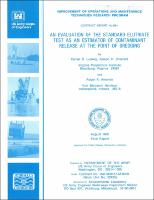Please use this identifier to cite or link to this item:
https://hdl.handle.net/11681/6182Full metadata record
| DC Field | Value | Language |
|---|---|---|
| dc.contributor | Virginia Polytechnic Institute and State University | - |
| dc.contributor | Fort Benjamin Harrison (Ind.) | - |
| dc.contributor | Improvement of Operations and Maintenance Techniques Research Program (U.S.) | - |
| dc.contributor.author | Ludwig, Daniel D. | - |
| dc.contributor.author | Sherrard, Joseph H. | - |
| dc.date.accessioned | 2016-03-21T21:48:14Z | - |
| dc.date.available | 2016-03-21T21:48:14Z | - |
| dc.date.issued | 1988-08 | - |
| dc.identifier.uri | http://hdl.handle.net/11681/6182 | - |
| dc.description | Contract Report | - |
| dc.description | Abstract: Release of contaminants during dredged material disposal operations has long been the subject of environmental concern. The potential release of pollutants during the dredging process has, in recent years, come under the scrutiny of Federal and State regulatory agencies. The mechanical action of a dredging operation causes resuspension of sediment particles and release of soluble contaminants to the water column. A predredging test is essential to estimate the amount of soluble release at or near the point of dredging to ascertain potential water quality impact. The Standard Elutriate Test has proven to be a good estimator of soluble contaminant release for dredged material disposal operations. The processes involved at the point of dredging are similar to those involved with open-water disposal of dredged material. This research is an evaluation of the Standard Elutriate Test as an estimator of soluble contaminant release at the point of dredging. Data and field studies were conducted by the US Army Engineer Waterways Experiment Station at four sites in the United States. A direct comparison was made between chemical concentrations in the test elutriate from sediment samples taken prior to dredging and corresponding concentrations in water samples taken at or near the point of dredging as sediment was being dredged. The Standard Elutriate Test satisfactorily predicted the release of soluble contaminants at or near the point of dredging at all four sites in this study. However, results indicated that the elutriate test appears to overestimate the release of organic materials, nutrients, and some heavy metals (mercury, manganese, iron, and chromium). Appendix A summarizes the data, and Appendix B outlines a statistical analysis that provided predictive equations which can be used to estimate the upper bound value that a constituent concentration will approach based on elutriate test data and a specified confidence level. | - |
| dc.publisher | Hydraulics Laboratory (U.S.) | - |
| dc.publisher | Engineer Research and Development Center (U.S.) | - |
| dc.relation | http://acwc.sdp.sirsi.net/client/en_US/search/asset/1003424 | - |
| dc.relation.ispartofseries | Contract report (U.S. Army Engineer Waterways Experiment Station) ; HL-88-1. | - |
| dc.rights | Approved for public release; distribution is unlimited. | - |
| dc.source | This Digital Resource was created from scans of the Print Resource | - |
| dc.subject | Cutterhead dredge | - |
| dc.subject | Soluble contaminant release | - |
| dc.subject | Standard Elutriate Test | - |
| dc.subject | SET | - |
| dc.subject | Dredging | - |
| dc.subject | Water quality | - |
| dc.subject | Water pollution | - |
| dc.subject | Dredging spoil | - |
| dc.subject | Environmental aspects | - |
| dc.subject | Environmental effects | - |
| dc.title | An evaluation of the standard elutriate test as an estimator of contaminant release at the point of dredging | - |
| dc.type | Report | en_US |
| Appears in Collections: | Contract Report | |
